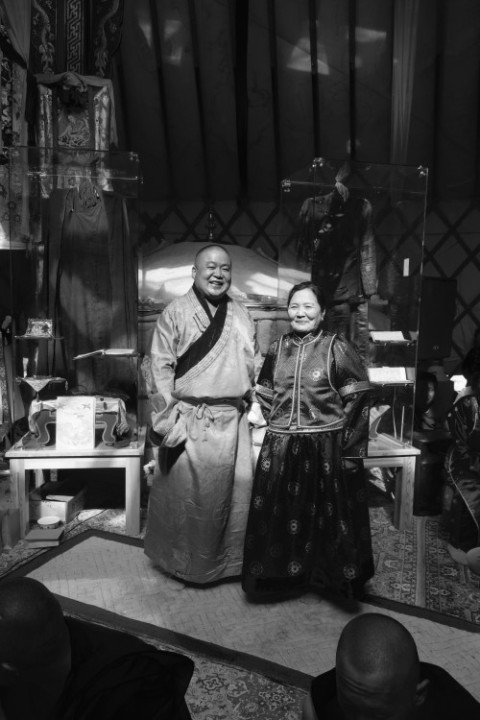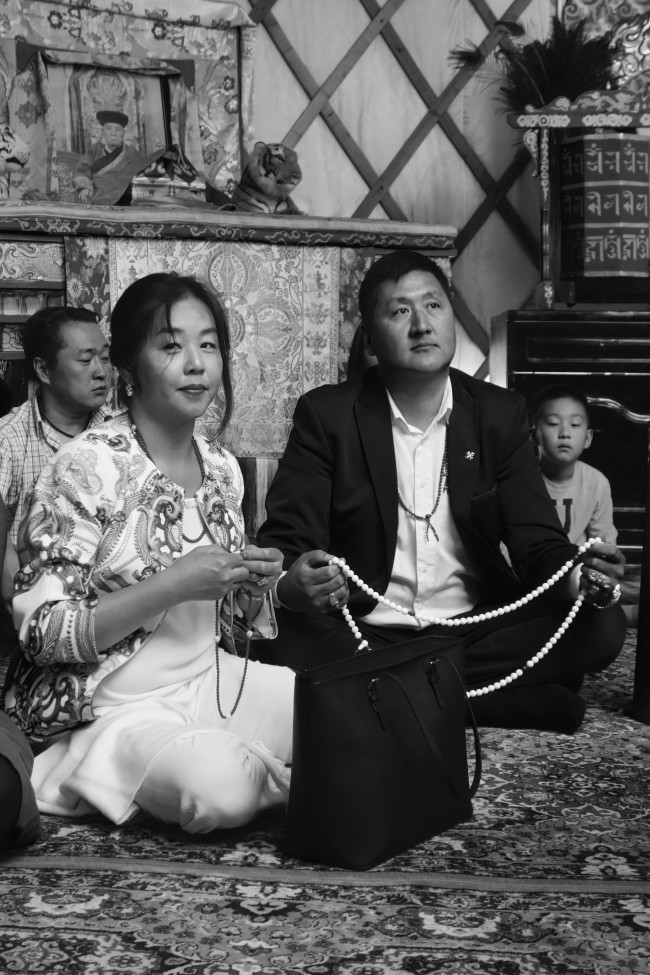The following photographs were taken at Delgeruun Choira in Mongolia on 5 September 2015 during Zava Bagsh’s day-long birthday celebrations. Reprinted here with permission of the Zava Damdin Institute of Mongolia. I would like to thank Sampel Lam for his assistance in articulating the annotations that accompany each photograph.
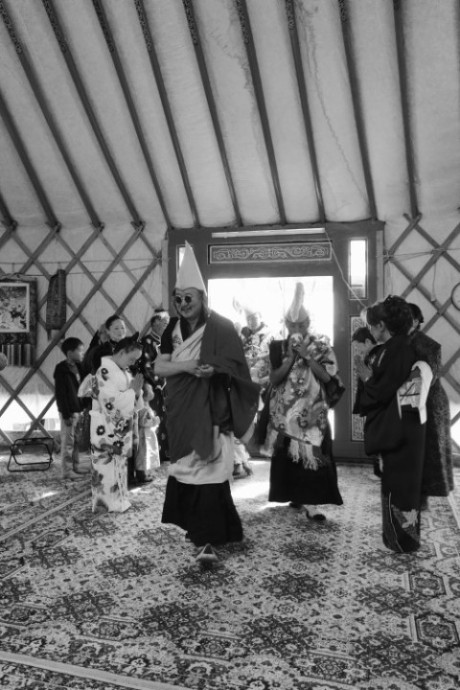
Zava Damdin Bagsh (centre), Sampel Lam blowing the conch (centre-right), Yamaguchi Toshiko (left), Takahata Sachiko and Toyoto Shizuyo (right). Delgeruun Choira 5 Sept. 2015. Photo: C.Pleteshner.
Here, from a Mongol Gelugpa lamas’ perspective, the performance (and heralding with conch) of Zava Bagsh’s entrance has since 2012 become an important annual ritual. Although now celebrated on the day of his birthday, it relives the first such entrance made by Zava Damdin Bagsh into the Majestic Shining White Palace ger at Delgeruun Choira immediately after the completion of his solitary four year Nenchen retreat in the same remote locale.
D. Bilguun’s hiaztai deel is hand-stiched, of yellow-gold silk brocade with a dragon motif and black trim. The selective and purposeful use of such colours in ‘traditional’ garments has important culturo-symbolic meanings. Although J. Gundegmaa is of the Borjigid lineage, she is seen here wearing a traditional Buryat-Mongol deel (a full length dress and vest) made of brown silk with a decorative motif, a beautiful hand-sewn gift from a woman-friend.
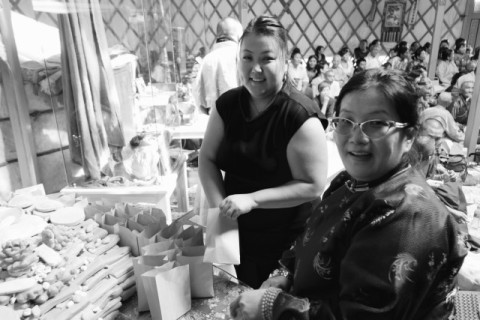
B. Enerel (left) and Solongo (right) here are seen assembling individual small packages of traditional tsog offerings to be handed to each of the guests who attended Zava Damdin Bagsh’s birthday celebration. Delgeruun Choira, 5 September 2015. Photo: C.Pleteshner
In general terms, a ‘tsog offering’ is an integral part of a Mongol Gelugpa Buddhist ritual performance. The purpose of the offering of tsog at the commencement of a special occasion such as this, is to invite lineage Gurus, Yidams, Buddhas and Bodhisattvas, Dakinis and Dakas and other selected deities from a Buddhist pantheon to the throng.
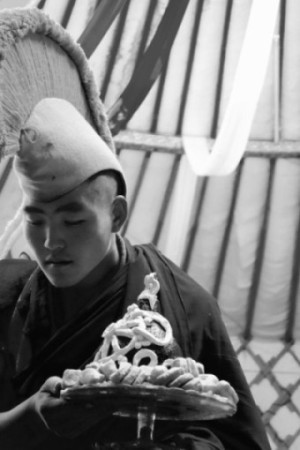
Pagchug Lam is carrying a Gelugpa Buddhist ritual Tsog Offering for Zava Damdin Bagsh. It is decorated with a Dharmachakra, Sun and crescent Moon, as well as other symbols that have been hand-made from local butter. The small flour-butter cakes surrounding the tsog offering torma (Tib. gtor ma), were made by J. Gundegmaa, Zava Damdin’s mother. Delgeruun Choira, 5 September 2015. Photo: C.Pleteshner
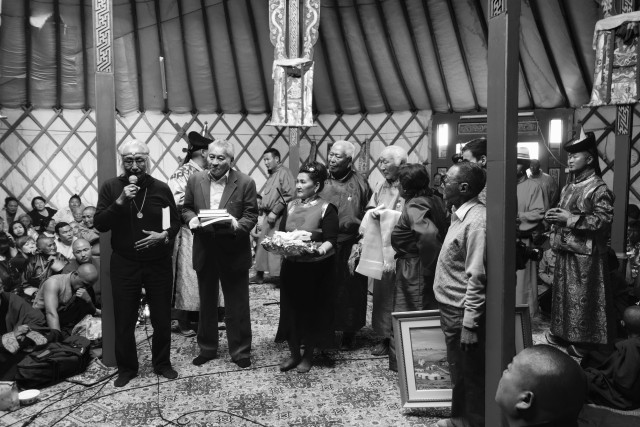
Enkhbaatar (far right), well-known lineage holder of traditional Mongolian Long Song (all genres) and Teacher at The Mongolian State University of Arts and Culture joins an assembly of Mongol scholars (art, literature, cultural studies and history) to make a speech in honour of Zava Damdin Bagsh’s birthday. Y. Sumiya (centre) on behalf of the group, is offering a platter of traditional Mongolian handmade cheeses and dried yoghurts, another established socio-cultural ritual that is customary at such events. Delgeruun Choira, 5 September 2015. Photo: C.Pleteshner
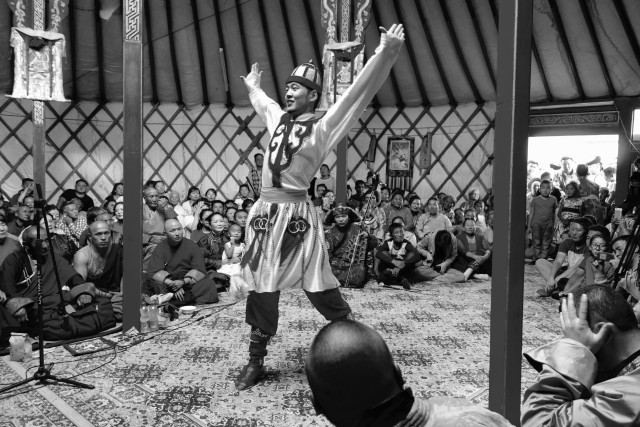
Urtnasan (principal dancer) here performs the first part of a work titled, ‘Let Me Merge With Your Body’ by Bayarbaatar (principal choreographer). Both are affiliated with the Mongolian National Folk Song and Dance Ensemble. This particular Mongolian dance, choreographed and first performed in 2014, has deep tantric and Buddhist associations. Delgeruun Choira, 5 September 2015. Photo: C.Pleteshner
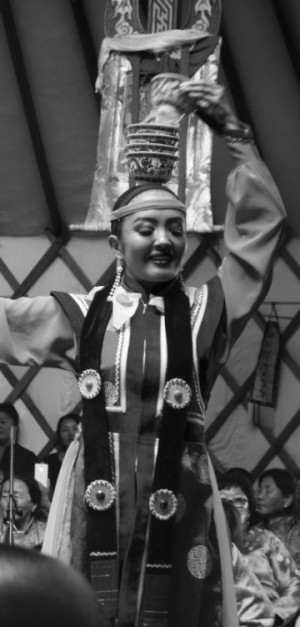
Suvdsuren from the Mongolian National Folk and Dance Ensemble performs, ‘Dancing with the Cups’, an old traditional Mongol dance performed always by women. Delgeruun Choira, 5 September 2015. Photo: C.Pleteshner
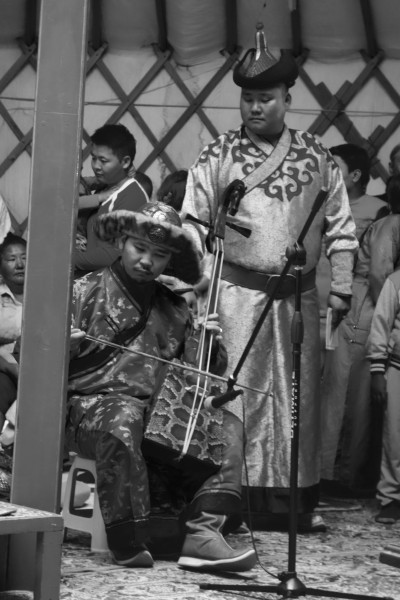
Munkhjin (left) Principal Artist on the morin khuur, and Zagdochir (right) Teacher of Mongol Humii are both from the Mongolian State University of Arts and Culture (MSUAC). Their performing costumes are a contemporary revision of previously traditional Mongol vestments. The costumes are theatrical rather than authentic. The timber front body of Munkhjin’s morin khuur (the soundboard) is covered with the skin of a snake. Delgeruun Choira, 5 September 2015. Photo: C.Pleteshner
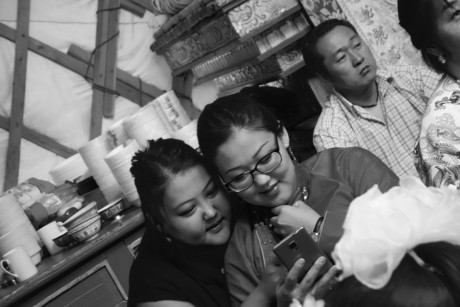
Enerel (left) and B. Enhluun(right) adjudicating their ‘selfies’ during an intermission. There was no shortage of iphones or androids amongst those who attended and participated in the day’s festivities, irrespective of socio-economic status (or at least the external appearances thereof). It appears that to be Mongolian in Mongolia these days, is to be (well) connected! Delgeruun Choira, 5 September 2015. Photo: C.Pleteshner
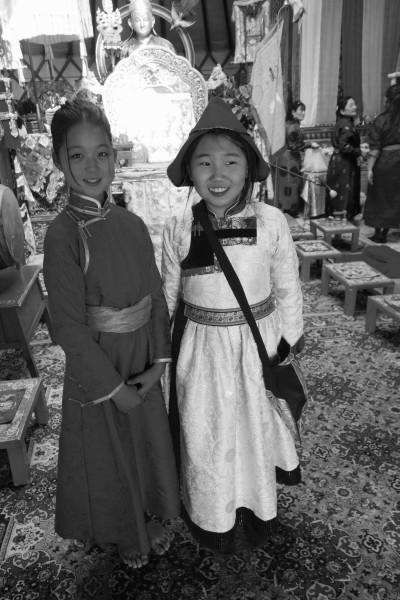
E.Dawaalham (left) and T. Khanaas (right) who is wearing a silk brocade traditional Buryat-style deel (Buriat, degel), and hat sewn for this special occasion by her maternal grand-mother. Dawaalham wears the traditional Khalkha Mongol deel and sash. To not draw the fabric of one’s deel in at the waist, with either a sash or a belt, is simply not the done thing. Delgeruun Choira, 5 September 2015. Photo: C.Pleteshner
Attribution
In keeping with ethical scholarly research and publishing practices and the Creative Commons Attribution 4.0 International License, I anticipate that anyone replicating the photographs or translating into another language all or part of this article and submitting it for accreditation or other purpose under their own name, to acknowledge this URL and its author as the source. Not to do so, is contrary to the ethical principles of the Creative Commons license as it applies to the public domain.
end of transcript.
Refer to the INDEX for other articles that may be of interest.
© 2013-2025. CP in Mongolia. This post is licensed under the Creative Commons Attribution 4.0 International License. Documents linked from this page may be subject to other restrictions. Posted: 4 October 2015. Last updated: 29 October 2017.
